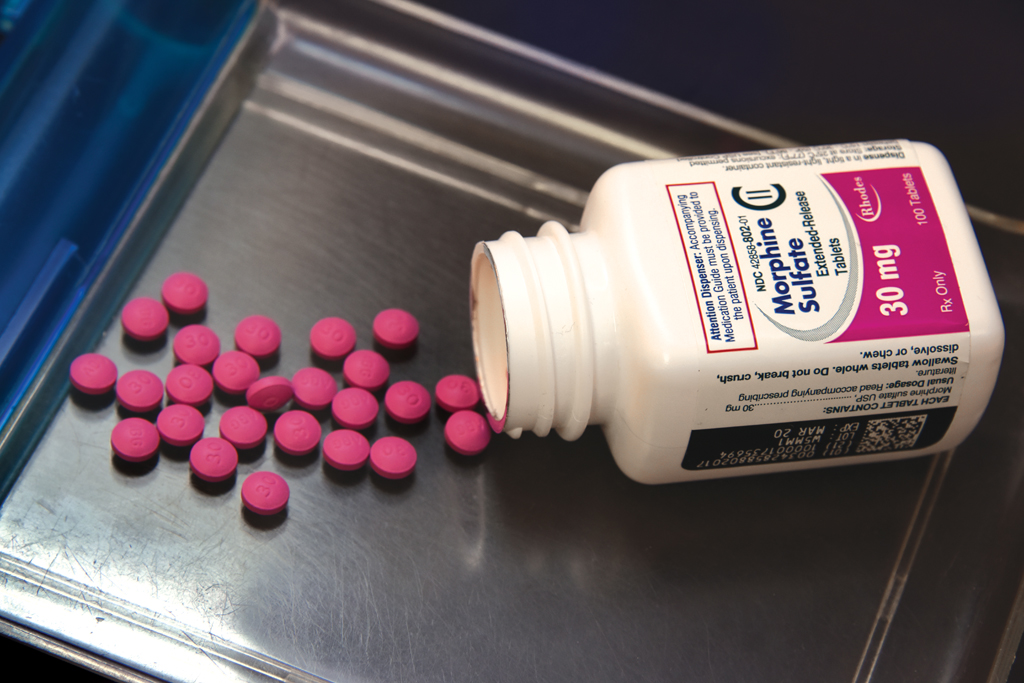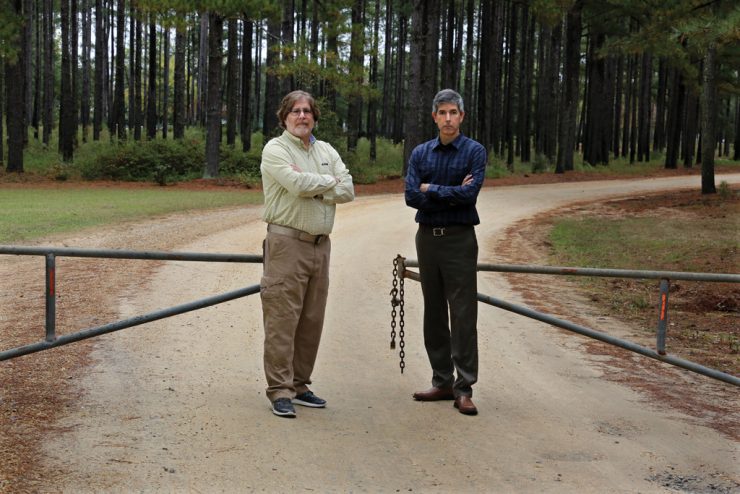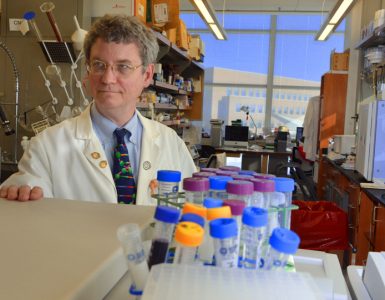Georgia’s Opioid crisis is devastating, and it could get a whole lot worse. Augusta University researchers are doing what they can to prepare.
Dr. Aaron Johnson, interim director of the Institute of Public and Preventive Health (IPPH) at Augusta University, talks a lot about substance abuse and treatment — he’s been doing so his entire career — but lately, that conversation is dominated by opioid addiction, and for good reason. Even before President Trump declared the opioid crisis a public health emergency, it was all over the headlines, whether from the seemingly endless number of celebrity overdoses or from the constant stream of everyday tragedies, the details of which often defy belief.
But in spite of the fact that the number of opioid overdose deaths in Georgia now eclipses the number of motor vehicle-related deaths, Johnson says it could get worse. A lot worse.
“I tell everybody who will listen to me that Georgia has been lucky so far,” he says. “It is significantly worse in Ohio, West Virginia, eastern Kentucky and the West Coast. But it’s coming, and I hope Georgia is prepared when it gets here.”
Already, the numbers are staggering. According to a white paper published by the Substance Abuse Research Alliance, 68 percent of the drug overdose deaths in Georgia in 2015 were due to opioid overdoses, and between 1999 and 2014, the state experienced a tenfold increase in prescription opioid overdose deaths.
And it’s far from an urban problem. In fact, according to the same report, 60 percent of the 55 Georgia counties with drug overdose rates higher than the national average in 2014 were located in rural areas.
The financial costs are jaw-dropping as well. Health care costs tied to opioid misuse were estimated at $447 million in 2007. Some now estimate that in the decade since, that cost has risen by 80 percent.
If this is what lucky looks like, you can understand why Johnson wants Georgia to prepare.
An Overnight Disaster Years in the Making
Few have such a firsthand understanding of the opioid epidemic as Dr. Bill Jacobs. Not only is he the chief of Addiction Medicine in the Department of Psychiatry and Health Behavior at the Medical College of Georgia, but he’s the medical director at Bluff Plantation, an addiction treatment facility affiliated with Augusta University.
He looks into the eyes of addiction every day, and he’s seen the crisis evolve.
“It’s finally getting some media play, but it’s been a growing issue since the mid-1990s, when we changed the treatment paradigm for treating chronic pain to giving everybody opiates until they said they didn’t hurt anymore,” Jacobs says. “We shifted our standard of care to that modality, and now we’ve finally realized that it doesn’t work.”
Several factors contributed to that shift. At the time, there was an aggressive marketing of prescription opioids — painkillers like oxycodone or hydrocodone — which were wrongly thought to be non-addictive. That coincided with a push to improve the treatment of pain in hospitals — patient satisfaction scores frequently hinged on how patients felt their pain levels were handled, so instead of being solely an aspect of treatment, pain management became attached to the bottom line. The American Pain Society also pushed to make pain the so-called fifth vital sign.
Meanwhile, the number of opioid prescriptions in the United States continued to climb, peaking at around 200 million prescriptions in 2011.
“The United States consumes about 90 percent of the world’s opiates and we make up 5 percent of the world’s population,” Jacobs says. “That tells you we’re either really cutting-edge with what we’re doing with our health care, or we’re really way off base, and I think it’s pretty clear we’re way off base.”
Jacobs throws out another startling statistic: The per capita consumption of opiates in the United States is double that of its nearest rival, Canada. Double.
Realizing prescription opiates were creating a real health hazard (opioid prescription-related deaths in Georgia peaked in 2014), regulations were enacted to limit the number of prescriptions. Prescription monitoring also became more stringent. Since July 1, 2018, physicians have been required to check the Georgia Prescription Drug Monitoring Program (PDMP) before writing an initial prescription for an opiate, then again every 90 days if the prescription continues. The PDMP is an electronic database used to help eliminate the overprescribing of controlled substances, thereby limiting a patient’s ability to obtain prescriptions from multiple doctors.
These moves combined with economic forces to create an almost immediate redistribution of the problem. Unable to obtain prescription opiates, those addicted to them turned to heroin, a cheaper alternative that was becoming much more readily available.
“You’ve already got all these people who have been exposed to these highly addictive substances,” Jacobs says. “They’re going to get their drugs from somewhere, and the illegal, illicit sources were happy to step in and fill that role.”
Throw in fentanyl, a synthetic opioid 40 times more powerful than heroin that dealers often add to heroin, and suddenly the heroin and synthetic opioid deaths start to skyrocket even as prescription opioid overdose deaths level off.
Different paths to the same destructive end.
Everybody’s Problem
While the worst of the crisis may not yet have reached Georgia, the state is extremely vulnerable. Other than Atlanta, it has only a couple of other metropolitan areas. The rest of the state is predominantly rural, which means the majority of Georgia counties do not have board-certified addiction medicine physicians or addiction psychiatrists.
And that’s a real problem when you look at the numbers.
According to Jacobs, only a tenth of the people needing addiction treatment ever receive it, and when they do, it’s usually only when they’ve hit some severe level of the disease.
“The analogy would be — there are a lot of people with diabetes, but we’re not going to treat them until they show up in a diabetic coma,” he says. “That’ll be the trigger for treating the diabetes — you show up in a coma.”
That’s pretty much what we’ve done with addiction, he says. When people overdose but don’t die, they sometimes get treatment.
But addiction is not an acute illness like, say, bronchitis, where a patient taking the right antibiotic in the right way results in a cure. It’s a chronic illness where a temporary treatment — even at a 28-day treatment center — can’t cure the problem on its own.
“All that does is help put the disease in remission,” Jacobs says. “But they have to continue to work a maintenance program in order to help keep the disease in remission, just like a diabetic has to do everything they do on a daily basis — watch blood sugars and diet, get exercise, take their medicines and go to follow-up appointments. It’s the same thing with addiction. We’ve got to do a better job recognizing that this is a chronic illness that needs long-term maintenance therapy if we’re going to get — and keep — people
in recovery.”
Conduct a thorough history of the patients in the Augusta University Medical Center at any given moment, he says, and you’ll discover that around 40 percent of the people have a problem with drugs or alcohol. Fifty percent of domestic violence cases are related to addiction, and 50 percent of fatal motor vehicle accidents are related to drug and alcohol problems.
“So we’re looking at a problem that’s affecting a huge percentage of the population, particularly the population that’s presenting for health care in a hospital setting,” he says.
However, the stigma associated with addiction makes providing that long-term treatment difficult, even though the American Medical Association passed a resolution all the way back in 1956 that said alcoholism was a disease and then included drug addiction as a disease in 1984. In spite of that, Jacobs says much of society continues to think people with addiction issues are somehow weak-willed or morally bankrupt, despite the evidence that indicates it’s primarily a disease of the brain.
“Just look around your neighborhood,” Jacobs says. “If you find out your neighbor who lives two doors down has cancer, everybody shows up with a casserole. But if you find out your neighbor two doors down has an addiction, nobody even wants to speak to him.”

Preparing for the Worst
In his role with the IPPH, Johnson is doing everything he can to help Georgia ready itself for the potential wave. It’s not sexy work and it’s never going to grab headlines, but the analytical, statistical research he’s doing is providing an important bridge between clinical trials and treatment.
“This not bench science; this is not clinical research — it’s health services research,” he says. “Almost all the work that’s happening here is being done in real-world settings. It’s focused on answering the question, ‘How do we take what we know works in terms of bench science or the clinical setting and get it to be used in the real world?’”
Given the scope and urgency of the problem, it seems like implementing — and sustaining — treatments already proven to be successful should be easy, but often it’s not. It requires convincing, and convincing requires proof, which is one of the reasons the research Johnson does is so valuable.
A perfect example is a grant from the Substance Abuse and Mental Health Services Administration (SAMHSA) that Johnson was involved with before coming to Augusta University. The grant put health education specialists — people trained in alcohol and drug screening and brief intervention — in the emergency departments in Macon and at Grady Hospital in Atlanta. It functioned just fine, Johnson says, as long as there was funding to support it. But as soon as the SAMHSA funding went away, the program went away, too.
So, with the idea of sustainability in mind, Johnson recently received a five-year, $5 million grant from SAMHSA’s Center for Substance Abuse Treatment that essentially funds a full-time licensed clinical social worker in each of the federally qualified health centers that fall in a geographic triangle formed by Augusta, Macon and Savannah. Known as the SBIRT Initiative for Georgia’s Rural and Underserved Populations (SIGRUP), it receives all funding for the position for one year, two-thirds the second year and one-third per year for the next three.
“That gradual decrease gives them five years to figure out how to fund the position,” he says.
And while licensed clinical social workers have the advantage of being able to provide other services such as depression counseling and HIV screenings, they also happen to be the cheapest of the few providers actually able to bill for drug and alcohol screenings and brief interventions. Johnson hopes this billing will make up for the funding gap starting in the second year so that the programs can sustain themselves.
“It’s more or less an organizational-level research project rather than a patient level research project,” Johnson says. “We want to see how these organizations adapt to having these licensed clinical social workers in there and how successful they are at billing the codes.”
He’ll track how much revenue they’re able to generate from the codes and whether it varies from site to site. Are the urban sites in Macon, Savannah and Augusta able to generate more or less revenue, for example, than a place with multiple clinics across multiple counties or someone who’s operating in a small urban setting?
Certainly not sexy, but undeniably important. And if it keeps these licensed clinical social workers in the federally qualified health centers after the five years are up, then the whole state benefits.
Further Study
According to Jacobs, this kind of research built around awareness and training dovetails with Augusta University’s unique commitment to ensure the health care of Georgians no matter where they live.
“Your academic medical centers have to be the leaders in this,” he says. “Go out and interview heath care providers in the community and ask them how much training they got when they were in school, and they’ll tell you they might have had a one-hour lecture, and that’s not going to do it.”
This is why the first thing Johnson did upon arrival at Augusta University was obtain a SAMHSA training grant to educate health professional students — those very positions Jacobs is talking about — in drug screening and brief intervention training. In three years, he trained more than 1,000 Augusta University students to identify and address unhealthy alcohol and drug use in patients.
“Hopefully, that will translate into practice,” Johnson says. “There are a huge number of chronic conditions — cancers, hypertension, liver disease, mental health conditions, obesity — that can be directly linked to an individual’s alcohol and drug use patterns, so when you sit down and see your patients, at least think about this patient’s chronic condition and how it may be linked to unhealthy alcohol or drug use. At least ask about it.”
Johnson is evaluating the effectiveness of several other responses
as well.
In late 2016, the director of the Georgia Department of Public Health issued a standing order that naloxone (Narcan), the opioid overdose reversal nasal spray, should be available in Georgia pharmacies without a prescription. Wanting to know the extent to which it was available, Johnson and his team conducted a stratified random sample of all Georgia pharmacies in the spring and called about 400 of them. They found that close to two-thirds said they had it, and a smaller percentage said they had actually sold a kit. Johnson’s team is repeating the study semi-annually to see if the inventory or sales have increased.
They are also assessing county-level overdose information to see if there is a relationship between county-level overdoses and the likelihood of a pharmacy stocking naloxone.
“Our hypothesis, obviously, is that the pharmacies in counties that have experienced the most overdoses are going to be more likely to stock it than the counties that haven’t been hit that hard,” he says.
Johnson, Jacobs and Dr. Lufei Young, associate professor in the College of Nursing, also received a $2 million SAMHSA grant that helps incarcerated individuals overcome substance use disorders as they return to their communities. The idea behind the Augusta Area Comprehensive Offender Re-entry Program is to begin treatment for substance use disorders while the offender is still incarcerated and work with local organizations to help with integration. The ultimate goal is to reduce the likelihood of relapse, rearrest and reincarceration.
Additionally, a grant awarded from the National Library of Medicine, an organization interested in improving health literacy in populations with health disparities, funds a partnership with Edovo, a social mission organization that has placed tablet computers in close to 70 jails and prisons across the country. The tablets currently contain educational content but will soon contain health information as a result of this grant. This will include practical information like how to find a primary care physician when released from prison or, if they have a chronic condition that requires ongoing medication, how to obtain that medication once they re-enter their communities. A couple of modules are related to substance abuse and give instructions on how to find a treatment provider when released.
Johnson is working also with Johns Hopkins University to evaluate a new grant-funded project they received to train nurse practitioner students to prescribe buprenorphine, an alternative to methadone, which until the early 2000s had been the primary means of treating opioid use disorders.
In 2002, the FDA approved buprenorphine, which is marketed under the names Suboxone and Subutex, for use in treating opioid use disorders. Unlike methadone, which can only be administered through a licensed methadone clinic, buprenorphine can be administered in private practices by primary care physicians and, since 2017, nurse practitioners and physician assistants who have become licensed prescribers.
“I’m an evaluator on that grant,” Johnson says. “When they graduate, they will be licensed to prescribe buprenorphine in the hopes that it will expand the availability of providers across the country so that individuals who have an opioid use disorder can find someone to help.”
It’s another example of expanding access to care and information — and learning from it.
And emerging from the Georgia attorney general’s office’s Statewide Opioid Task Force, hosted on campus in August 2018,
an Augusta University working research group has begun meeting with the hope of identifying additional ways the different colleges might collaborate.
“What we’ve noticed is that everywhere on campus is affected by opioids,” says Scott Thorp, associate vice president for interdisciplinary research. “It’s just running throughout everything.”
The widespread impact presents a significant number of added research opportunities, and Thorp says the group not only helps focus reaction to these opportunities, but it broadens their overall understanding.
“We have to understand what we’re doing and bring all of our resources together to really get some good grant submissions out there,” Thorp says. “And it also helps that when we put all these people in a room and somebody’s got an opportunity they’re looking to pursue, there’s likely someone else who can help with that.”
Small steps toward a big solution, each offering hope to those in need, and all guided by the belief that knowledge requires understanding, and understanding doesn’t come easily.






